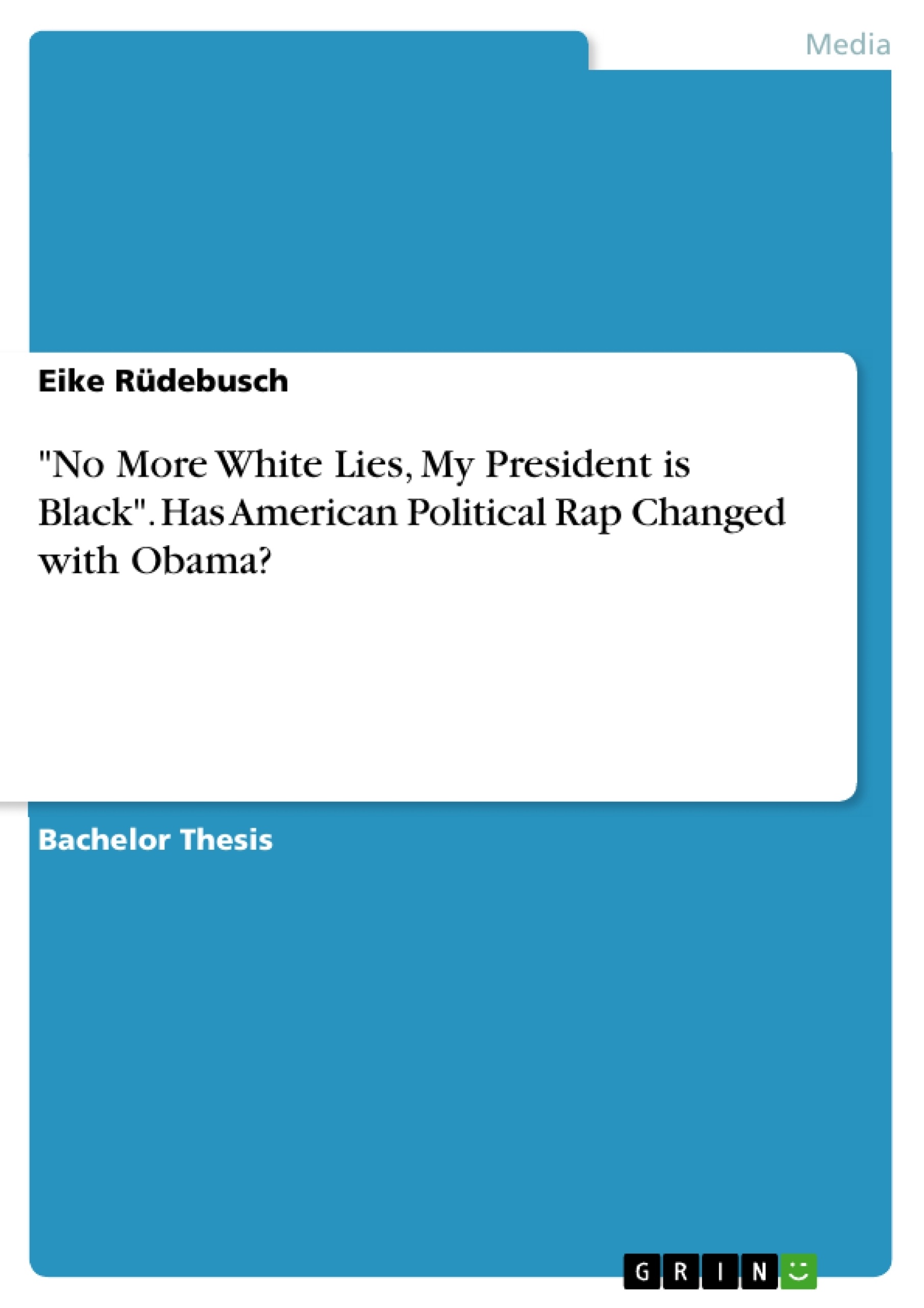Nearly 400 years after slavery in the United States (US) begun an African American, actually a man of half African and half American descent, has probably changed the United States forever.
During his election campaign, he promised hope and change. His words inspired millions all over the world, not only in the US. Just by campaigning Obama changed the world‘s views on the United States. Moreover, and this will form the thesis of this paper, Obama has changed Hip Hop as well.
With every step taken in African American history, considering being brought to America as the first and Obama being elected president the most recent one, African American music has changed. Until Obama appeared the changes have mostly been stylistically, afterwards it mostly changed content-wise.
The first chapter of this paper will deal with the first 300 years of African American music in the US and will present an overview of the developments in African American music that lead to Hip Hop as we know it. The second chapter will be about the first decade of Hip Hop, the 1970s. I will describe the circumstances that led to and accompanied the evolution of Hip Hop, with a special focus on Hip Hop‘s birthplace, New York City. Chapter three will deal with the rebellious and radical era of political rap in the 1980s, coined by rap groups such as Public Enemy and Boogy Down Productions.
In chapter four I will discuss the 1990s and its so-called political nihilism. Gangsta rap was and is generally seen as nihilistic and nonpolitical. But, having a closer look at it I will show that Gangsta rappers also reflected the political circumstances around them, and therefore following the traditions of African American music of the preceding decades to criticize those who vice versa criticized them. In addition, to the commercially successful gangsta rap, I will also discuss so-called conscious rap of the 1990s.
The years under the George W. Bush administration will be the topic of the fifth chapter. Bush‘s inner and foreign policies, 9/11 and the disaster of Hurricane Katrina led to a whole new focus of political rap.
The final chapter will deal with Obama and Hip Hop‘s reaction towards him as a person, as a political figure and his politics. Rap has let its skepticism behind, in order to publicly endorse and support a presidential candidate. Vice versa, Obama represents a new political style towards Hip Hop.
Table of Contents
- Introduction
- Hip Hop and Rap: Children of the 1970s
- Media Background of Rap
- New York in the 1970s
- Hip Hop as a Counter Reaction to the Conditions in the Ghetto
- Rebellion in Rap: The 1980s
- Radical Political Ideas Before Rap
- Radical Political Ideas in Rap
- Guns, Violence, Drugs and Jewelry: The 1990s
- Gangsta Rap and Black Nationalist Ideas
- Conscious Rap
- Political Rap Equals Popular Rap: The Bush Administration
- 9/11 - The War on Terrorism
- Elections 2004: Vote or Die
- Katrina Klap 2005
- People Who Love Hip Hop Love Obama
- Obama and Race
- Obama and Rap
Objectives and Key Themes
This paper examines the impact of Barack Obama's presidency on American political rap music. It aims to show how the emergence of the first African-American president has shifted the focus and content of hip hop, a predominantly African-American subculture, and how it has influenced the relationship between the genre and politics.
- The historical development of African-American music in the United States leading to Hip Hop
- The socio-political context of Hip Hop's origins and its relationship with African-American culture
- The evolution of political rap music from its early rebellious roots in the 1980s through the 1990s and into the Bush administration era
- The impact of Obama's presidency on Hip Hop's political discourse and its relationship with power structures
- The influence of African-American cultural and political movements on Hip Hop and its artists
Chapter Summaries
The first chapter discusses the historical development of African-American music in the United States, tracing the evolution of the genre from its roots in traditional African music to the emergence of Hip Hop. The second chapter focuses on the early years of Hip Hop in the 1970s, exploring its roots in New York City's social and economic conditions and its development as a counter-cultural movement. The third chapter analyzes the political and radical nature of rap music in the 1980s, focusing on the influence of figures like Malcolm X and the Nation of Islam on groups like Public Enemy and Boogie Down Productions. The fourth chapter explores the 1990s, a period marked by the rise of Gangsta rap and its often perceived nihilism. This chapter will demonstrate that even this subgenre of rap reflected the political and social circumstances of the era, continuing the tradition of critical engagement. Finally, the fifth chapter examines the impact of the Bush administration on political rap, specifically analyzing the influence of 9/11, the 2004 elections, and Hurricane Katrina on the genre's content and messaging.
Keywords
This paper explores the intersection of African-American culture, politics, and music. Key themes include the historical development of African-American music, the social and political context of Hip Hop, political rap, Black Nationalism, Gangsta rap, conscious rap, the influence of Malcolm X and the Nation of Islam, and the impact of Barack Obama's presidency on hip hop culture.
- Citar trabajo
- Eike Rüdebusch (Autor), 2010, "No More White Lies, My President is Black". Has American Political Rap Changed with Obama?, Múnich, GRIN Verlag, https://www.grin.com/document/150586



